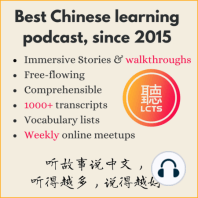2 min listen
2.1.14B 故事解读《小蝌蚪找妈妈》
ratings:
Length:
27 minutes
Released:
Oct 4, 2016
Format:
Podcast episode
Description
New words and grammatical structures in the story are being taught in this episode. A lot of repetitions are used so that our learners can get master this story in no time! Enjoy the lesson and please find the new word list on our website: www.learningchinesethroughstories.com 蝌蚪 kēdǒu Noun, tadpole 池塘 chítáng Noun, pond 游泳池,swimming pool 脑袋 nǎodai Noun, brain 甩 shuǎi Verb, to whip 歌曲《一个人的精彩》 快活 kuàihuó Adj, happy 啊(哇) a (wa) Verb+啊+verb, doing something without a stop 吃啊吃,eat and eat 走哇走,walk and walk 鲤鱼 lǐyú Noun, carp 捕食 bǔshí Verb phrase, (predators) hunt for food 迎 yíng Verb, to go to meet; to welcome 宽 kuān Adj, wide 乌龟 wūguī Noun, turtle 摆动 bǎidòng Verb, to sway; to swing 连忙 liánmáng Adv, promptly; immediately; instantly Or 赶忙,赶紧 追 zhuī Verb, to chase 顶上 dǐng shàng Pronoun, the top (side) 披 pī Verb, to drape over (ones’ shoulder) 衣裳 yīshang Noun, clothes 荷花 héhuā Noun, lotus flower 荷叶 hé yè Noun, lotus leaf 蹲 dūn Verb, to squat 青蛙 qīngwā Noun, frog 碧绿 bì lì Adj, green as a jade 露 lòu Verb, to expose 雪白 xuěbái Adj, white as snow 肚皮 dùpí Noun, belly 鼓 gǔ Verb, to bulge 对 duì Measure word for a pair of eyes, ears, earrings, bracelets, twins. Cannot use for shoes, socks, chopsticks 蹬 dēng Verb, to thrust against 跳 tiào Verb, to jump 蹦 bèng Verb, to hop 捉 zhuō Verb, to catch; to capture 害虫 hàichóng Noun, pest
Released:
Oct 4, 2016
Format:
Podcast episode
Titles in the series (100)
2.2.8A 成语故事《自相矛盾》: This is an Chengyu (Chinese idiom) story about an ancient street vendor who was being inconsisten... by Learning Chinese through Stories
